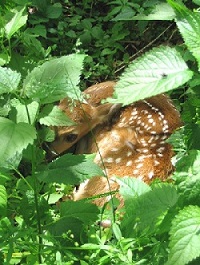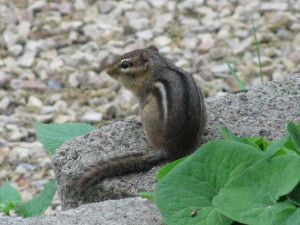by Winding Pathways | Apr 3, 2016 | Mammals, Nature, Pests

Deer drop fawns in our front yard labyrinth.
Few gardening experiences are as frustrating as discovering a patch of almost ready-to-bloom tulips or ready-to-pick green beans devoured by deer.
Over the past couple of decades deer populations have skyrocketed across North America, making gardening challenging. We have plenty of deer at Winding Pathways and have tried or researched many ways to either eliminate or greatly reduce damage. Here they are:
PLANT CROPS, FLOWERS AND SHRUBS DEER DON’T LIKE: This only sort of works. There are a few plants deer don’t like to eat. Books, blogs, and magazine articles contain lists of plants deer don’t like, but beware. As deer herds increase they get every hungrier, eliminate their favorite foods, and then chow down on plants they don’t particularly like. Also, deer seem to have regional preferences. Connecticut deer may avoid a certain plant that Iowa counterparts love. Winding Pathways Advice: Assume that sooner or later deer will eat just about any plant with only a few exceptions.
KENNEL A BIG DOG IN THE GARDEN: We haven’t tried this one but we’re guessing that the deer will soon figure out that the dog is tied or fenced in and they’ll eat plants just out of Fido’s reach. Winding Pathways Advice: Fido might help but don’t count on him.
SPRAY DEER REPELLENTS ON DESIRABLE PLANTS: It works much of the time. Many commercial repellents are on the market. We’ve made ours from egg yolks blended in water, strained through a nylon stocking to remove most of the thicker egg material and sprayed on plants. At best it is a temporary solution. Really hungry deer will eat the plants anyway, and rain washes most repellents off. Read labels. Some commercial repellents may not be safe on vegetables. Winding Pathways Advice: Repellents help but need to be reapplied after each rain and the deer will find the one plant you overlooked!
BUILD A FENCE: Tall mesh fences work. Electric fences work. Electrified mesh fences work the best. If you want a surefire way to keep deer out build a sturdy fence all the way around the garden. Unfortunately, there are some disadvantages of fencing as follows:
- Electric and tall nonelectric fences are often prohibited by town ordinances
- Fences are expensive but last a long time.
- Fences can be unsightly
- Fences are barriers to both deer and people. Building a fence means passing through a gate every garden visit.
Fences work. If nonelectrified they should be at least seven feet tall. Eight is better. Electric fences don’t need to be as tall and can be several strands of wire or (better) an electrified mesh.
Winding Pathways Advice: This is the one surefire way of keeping deer away from valuable plants. Just remember to close the gate!
WHAT WE’VE DONE AT WINDING PATHWAYS
We take a comprehensive approach to reducing deer damage to our labyrinth, vegetable garden and favorite landscape plants. Here is what we have done and are contemplating.
- Built a 7-foot tall nonelectric fence around our smallish vegetable garden.
- Built sturdy nonelectric fences around young trees.
- Use repellents frequently on special non edible plants.
- Buy a deer tag and harvest one deer per year. It’s legal where we live and we enjoy this
“local free ranging, organic” meat.
We’re considering buying and setting up an electric mesh fence around our labyrinth.
Farm and garden stores sell a wide diversity of nonelectric fencing. Our favorite resource for fences is Premier1. Their FENCES THAT WORK catalog is an outstanding resource. Check out Premier1 in Washington, IA.
by Winding Pathways | May 4, 2015 | (Sub)Urban Homesteading, Amphibians/Reptiles, Garden/Yard, Nature
The annual evening toad serenade has begun! From May into summer rural and urban folks can enjoy the loud trilling announcing toad lovemaking season. Nature’s summer music.
As amphibians, toads require standing water to reproduce but unlike many frogs they don’t need watery abundance. Toads lay their eggs in small pools that often dry up by summer. Eggs hatch quickly into tiny black tadpoles. While bullfrog tadpoles take two years to change into adult frogs, toad tadpoles are speedsters that transform into tiny hopping miniature adults by mid-summer. Often hundreds of these tiny creatures can be spotted seeking cool damp places to live.
Toads are voracious insect eaters, and gardeners delight in having them live under squash vines or tomato plants. Some people even construct tiny toad homes to encourage them to live in the garden.
We’re lucky to have a big toad living in a shed near our garden. His home is damp and cool with plenty of insects to keep him well fed.
According to the National Wildlife Federation, when pestered, toads eject a watery toxic substance from the parotoid glands. The toxin discourages dogs, raccoons or other hungry varmints intent on a meal from eating them. Few predators bother the placid toad. This bufotoxin can cause an allergic reaction in people. But humans do NOT get “warts” from toads.
Homeowners can encourage toads to take up residence. Building a small pond creates a toad magnet and maintaining a few damp places in the garden will provide toad homes. Avoid insecticides and, thus, encourage worms and insects for these intriguing animals to gorge on.
Kids love toads. When our children, Dan and Nancy, as small children delighted in watching them in our small backyard pond. Toads help transform a boring yard into a wondrous one!
by Winding Pathways | Jul 14, 2014 | (Sub)Urban Homesteading, Chickens, Garden/Yard, Mammals, Nature, Pests

The charming but pesky chipmunk is an amazing forager and storer of food.
Wildlife sometime create yard mischief. Raccoons, possums, and skunks tip over trash cans in the middle of the night. Chipmunks tunnel under walls, moles heap mounds of dirt. And woodchucks and cottontails raid the garden.
Damage, or perceived damage, often infuriates homeowners. Woodchucks have the uncanny ability to harvest lettuce the day before it is to be picked for an evening salad, and raccoons raid the sweet corn patch the moment ears are ripe. Moles hump up hills of dirt that lawnmowers hit, and skunks mine into the sod for grubs. What’s a homeowner to do?
WHY WILDLIFE CAUSE PROBLEMS
There’s no mystery to it. Wild animals are attracted to yards because they are comfortable places to live or find food. All living creatures need food, shelter and water to live. Yards frequently offer these basic needs all in proximity. Create a beautiful diverse yard and wildlife will enjoy it as much as people. In most cases people love seeing most species of wildlife in their yards, but often agree that they are best enjoyed in moderation.
THREE STEPS TO CONTROL GARDEN WILDLIFE DAMAGE
There are three ways to effectively overcome, or at least minimize, wildlife damage.
Homeowners differ in their strategy on how they weigh the benefits versus problems of wildlife in the yard.
Strategy One: Tolerate damage and enjoy wildlife.
It’s a state of mind that may require attitude adjustment. How important is a perfect lawn or head of cabbage, versus watching a cottontail mom peacefully nurse her babies on the edge of the law? How valuable is the beauty and inspiration gained from seeing chipmunks pack their cheeks with seeds and scamper across the yard versus the tunnels they make in retaining walls? For many people having beautiful and interesting wildlife out the window far outweighs damage they may cause.
We had a friend who grew a tiny garden with a few lettuce plants, a short row of string beans, and one hill of summer squash. When a cottontail devoured them she was incensed and declared war on bunnies. She bought traps but never managed to catch them. She built a fence but the lettuce thieves found their way under it. Her stress level rose as plants disappeared.
We suggested she might rely on simple arithmetic to solve her problem.
“Instead of spending about a hundred bucks on fencing and traps, wouldn’t it be simpler and cheaper to just buy lettuce, squash, and beans at the farmer’s market”, we asked her. She agreed. It took some mental adjustment, but now she buys locally grown vegetables and enjoys watching the cottontails that she once hated.
SOMETIMES IT’S BEST TO JUST IGNORE MINOR DAMAGE AND ENJOY WILDLIFE.
Strategy two. Preventing damage in the first place.
The saying, “An ounce of prevention is worth a pound of cure,” holds true for wildlife damage. In most cases homeowners can both enjoy wildlife and prevent or greatly reduce damage critters might do. Some simple ways to anticipate and reduce conflict include:
Fencing: Craft fences sturdy enough to keep rabbits and woodchucks out of the garden. Cottontails, for example can jump a long ways horizontally but not high vertically. An inexpensive 18 “ tall temporary fence of chicken wire will keep them out of the garden. Woodchucks are more challenging, as they are expert diggers and climbers. A garden fence needs to extend below the ground to keep them out and needs to be at least three or four feet tall. Watch for more fencing specifics in future editions of Winding Pathways website.
Securing: Store trash cans inside the garage with the door closed to keep raccoons from tipping it over. Better yet, compost food scraps and don’t put anything in the can that will interest wildlife. Composting turns waste into a wonderful resource that improves the soil. Don’t let the trash man cart it away. Some people who prefer not to add meat scraps to the compost bin, feed them to a small flock of chickens or simply put them on the edge of the yard in the evening for the raccoons to devour. No more tipping over the trash can.
PREVENTION IS A KEY
Strategy three: Killing the offending animal.
Often people resort first to killing an animal. However killing a few woodchucks, raccoons, moles, or chipmunks will not solve damage problems. These animals are in the yard because they find perfect conditions there to live. Remove a few and others will move in. Keep killing and you’ve created a wildlife death trap.
Sometimes it is necessary to kill an animal. Upcoming issues of Winding Pathways will feature tips on how to eliminate problem animals.


